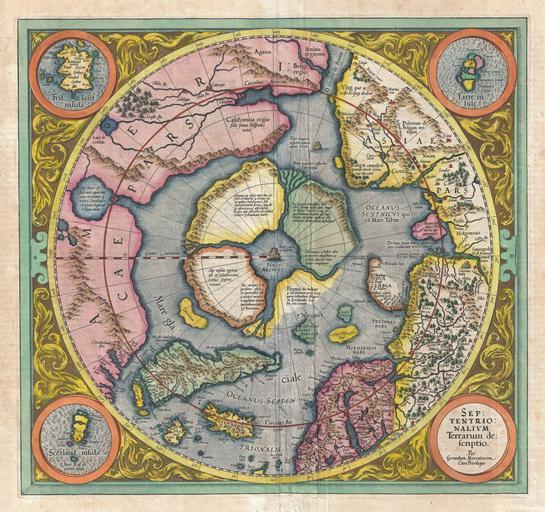MAKE A MEME
View Large Image

| View Original: | 1606_Mercator_Hondius_Map_of_the_Arctic_(First_Map_of_the_North_Pole)_-_Geographicus_-_NorthPole-mercator-1606.jpg (3500x3290) | |||
| Download: | Original | Medium | Small | Thumb |
| Courtesy of: | commons.wikimedia.org | More Like This | ||
| Keywords: 1606 Mercator Hondius Map of the Arctic (First Map of the North Pole) - Geographicus - NorthPole-mercator-1606.jpg InteractiveViewer This is the second edition of Gerard Mercator's map of the North Pole or Arctic one of the great cartographer's most interesting and important maps Mercator's Arctic projection has its roots in his magnificent 1569 wall map of the world in which Mercator first introduces his revolutionary projection As regards the Arctic the difficulty with the Mercator Projection is that to accurately depict the Polar Regions his map would have to be infinitely tall Mercator compensated for this by included a polar projection very similar to the map shown here in the lower-left hand corner of his great map This may rightly be considered to be the world's first specific map of the north pole Mercator later reissued this map in an expanded format for his 1595 atlas Following a number of important expeditions to the Arctic in subsequent 10 years Mercator's successor Jodocus Hondius reissued the original 1595 map with a number of revolutionary and highly significant changes Our survey of this map must naturally being with the North Pole itself which Mercator envisions as a large black rock the Rupes Nigra surrounded by a great whirlpool into which four powerful rapid rivers flow These rivers divide a massive continent sized landmass into four distinct islands or countries When the English polymath John Dee wrote to Mercator asking about his sources for this map Mercator returned the following letter which survives in his own hand In the midst of the four countries is a Whirl-pool into which there empty these four indrawing Seas which divide the North And the water rushes round and descends into the Earth just as if one were pouring it through a filter funnel It is four degrees wide on every side of the Pole that is to say eight degrees altogether Except that right under the Pole there lies a bare Rock in the midst of the Sea Its circumference is almost 33 French miles and it is all of magnetic Stone � This is word for word everything that I copied out of this author years ago The author that Mercator refers to is generally believed be Jocobus Cnoyen van Herzogenbusch who is himself referencing an enigmatic lost work the Inventio Fortunata Little is known of the Inventio Fortunata Fortunate Discoveries save that it was composed in the 14th century and was a well known resource for cartographers of the 15th and 16th centuries The author of this work is a figure of considerable mystery and arguments have been made that he is Nicholas of Lynn Thomas Kingsbury or Hugh of Ireland The work tells of a Minorite monk from Oxford who traveled extensively in northern lands including Iceland Greenland Norway and possibly even Labrador The Inventio Fortunata also itself references a far older and similarly lost work the Gestae Arthuri which adds a new chapter to the legend of King Author citing that his warriors conquered Iceland Greenland the Faroes and parts of Norway Regardless of the attribution of Mercator's sources the idea of the Arctic being divided into four lands surrounding a black magnetic rock was even in the 16th century not new Variants on the magnetic rock them the Rupes Nigra can be found in such esteemed references such as the texts of Ptolemy which identifies sever such The presence of such a magnetic mountain at the extreme north may have seemed a natural connection for scholars attempting to explain the wonders of the compass Curiously though referencing the Inventio Fortunata with regard to the presence of the Rupes Nigra at the Arctic Pole Mercator does not ascribe to it any magnetic property 1606 undated Size in 16 15 object history credit line accession number NorthPole-mercator-1606 Mercator G and Hondius J <i>Atlas</i> 1606 Geographicus-source PD-Art-100 Old maps of the Arctic 1606 maps Maps by Gerardus Mercator Images from Geographicus Maps in Latin Old maps of Greenland Old maps of Iceland Old maps of Scandinavia Old maps of Tsardom of Russia Old maps of phantom islands Maps of Iceland made in the 17th century Maps by Hendrik Hondius the Younger | ||||